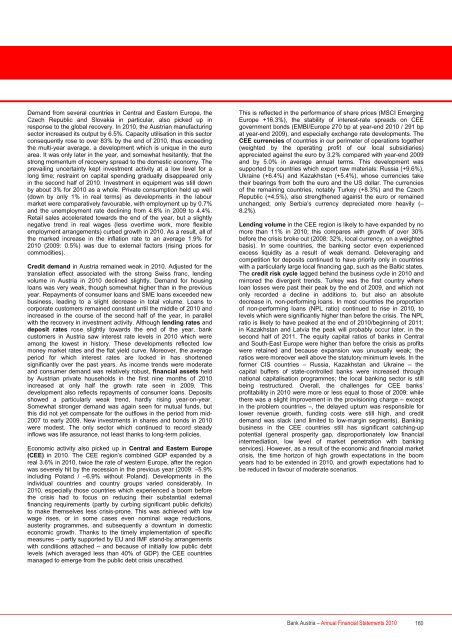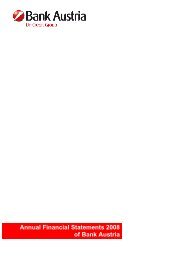Annual Financial Statements 2010 of Bank Austria
Annual Financial Statements 2010 of Bank Austria
Annual Financial Statements 2010 of Bank Austria
You also want an ePaper? Increase the reach of your titles
YUMPU automatically turns print PDFs into web optimized ePapers that Google loves.
Management Report <strong>of</strong> UniCredit <strong>Bank</strong> <strong>Austria</strong> AG<br />
Demand from several countries in Central and Eastern Europe, the<br />
Czech Republic and Slovakia in particular, also picked up in<br />
response to the global recovery. In <strong>2010</strong>, the <strong>Austria</strong>n manufacturing<br />
sector increased its output by 6.5%. Capacity utilisation in this sector<br />
consequently rose to over 83% by the end <strong>of</strong> <strong>2010</strong>, thus exceeding<br />
the multi-year average, a development which is unique in the euro<br />
area. It was only later in the year, and somewhat hesitantly, that the<br />
strong momentum <strong>of</strong> recovery spread to the domestic economy. The<br />
prevailing uncertainty kept investment activity at a low level for a<br />
long time; restraint on capital spending gradually disappeared only<br />
in the second half <strong>of</strong> <strong>2010</strong>. Investment in equipment was still down<br />
by about 3% for <strong>2010</strong> as a whole. Private consumption held up well<br />
(down by only 1% in real terms) as developments in the labour<br />
market were comparatively favourable, with employment up by 0.7%<br />
and the unemployment rate declining from 4.8% in 2009 to 4.4%.<br />
Retail sales accelerated towards the end <strong>of</strong> the year, but a slightly<br />
negative trend in real wages (less overtime work, more flexible<br />
employment arrangements) curbed growth in <strong>2010</strong>. As a result, all <strong>of</strong><br />
the marked increase in the inflation rate to an average 1.9% for<br />
<strong>2010</strong> (2009: 0.5%) was due to external factors (rising prices for<br />
commodities).<br />
Credit demand in <strong>Austria</strong> remained weak in <strong>2010</strong>. Adjusted for the<br />
translation effect associated with the strong Swiss franc, lending<br />
volume in <strong>Austria</strong> in <strong>2010</strong> declined slightly. Demand for housing<br />
loans was very weak, though somewhat higher than in the previous<br />
year. Repayments <strong>of</strong> consumer loans and SME loans exceeded new<br />
business, leading to a slight decrease in total volume. Loans to<br />
corporate customers remained constant until the middle <strong>of</strong> <strong>2010</strong> and<br />
increased in the course <strong>of</strong> the second half <strong>of</strong> the year, in parallel<br />
with the recovery in investment activity. Although lending rates and<br />
deposit rates rose slightly towards the end <strong>of</strong> the year, bank<br />
customers in <strong>Austria</strong> saw interest rate levels in <strong>2010</strong> which were<br />
among the lowest in history. These developments reflected low<br />
money market rates and the flat yield curve. Moreover, the average<br />
period for which interest rates are locked in has shortened<br />
significantly over the past years. As income trends were moderate<br />
and consumer demand was relatively robust, financial assets held<br />
by <strong>Austria</strong>n private households in the first nine months <strong>of</strong> <strong>2010</strong><br />
increased at only half the growth rate seen in 2009. This<br />
development also reflects repayments <strong>of</strong> consumer loans. Deposits<br />
showed a particularly weak trend, hardly rising year-on-year.<br />
Somewhat stronger demand was again seen for mutual funds, but<br />
this did not yet compensate for the outflows in the period from mid-<br />
2007 to early 2009. New investments in shares and bonds in <strong>2010</strong><br />
were modest. The only sector which continued to record steady<br />
inflows was life assurance, not least thanks to long-term policies.<br />
Economic activity also picked up in Central and Eastern Europe<br />
(CEE) in <strong>2010</strong>. The CEE region’s combined GDP expanded by a<br />
real 3.6% in <strong>2010</strong>, twice the rate <strong>of</strong> western Europe, after the region<br />
was severely hit by the recession in the previous year (2009: –5.9%<br />
including Poland / –6.9% without Poland). Developments in the<br />
individual countries and country groups varied considerably. In<br />
<strong>2010</strong>, especially those countries which experienced a boom before<br />
the crisis had to focus on reducing their substantial external<br />
financing requirements (partly by curbing significant public deficits)<br />
to make themselves less crisis-prone. This was achieved with low<br />
wage rises, or in some cases even nominal wage reductions,<br />
austerity programmes, and subsequently a downturn in domestic<br />
economic growth. Thanks to the timely implementation <strong>of</strong> specific<br />
measures – partly supported by EU and IMF stand-by arrangements<br />
with conditions attached – and because <strong>of</strong> initially low public debt<br />
levels (which averaged less than 40% <strong>of</strong> GDP) the CEE countries<br />
managed to emerge from the public debt crisis unscathed.<br />
This is reflected in the performance <strong>of</strong> share prices (MSCI Emerging<br />
Europe +16.3%), the stability <strong>of</strong> interest-rate spreads on CEE<br />
government bonds (EMBI/Europe 270 bp at year-end <strong>2010</strong> / 291 bp<br />
at year-end 2009), and especially exchange rate developments. The<br />
CEE currencies <strong>of</strong> countries in our perimeter <strong>of</strong> operations together<br />
(weighted by the operating pr<strong>of</strong>it <strong>of</strong> our local subsidiaries)<br />
appreciated against the euro by 3.2% compared with year-end 2009<br />
and by 5.0% in average annual terms. This development was<br />
supported by countries which export raw materials: Russia (+9.6%),<br />
Ukraine (+6.4%) and Kazakhstan (+5.4%), whose currencies take<br />
their bearings from both the euro and the US dollar. The currencies<br />
<strong>of</strong> the remaining countries, notably Turkey (+8.3%) and the Czech<br />
Republic (+4.5%), also strengthened against the euro or remained<br />
unchanged; only Serbia’s currency depreciated more heavily (–<br />
8.2%).<br />
Lending volume in the CEE region is likely to have expanded by no<br />
more than 11% in <strong>2010</strong>; this compares with growth <strong>of</strong> over 30%<br />
before the crisis broke out (2008: 32%, local currency, on a weighted<br />
basis). In some countries, the banking sector even experienced<br />
excess liquidity as a result <strong>of</strong> weak demand. Deleveraging and<br />
competition for deposits continued to have priority only in countries<br />
with a particularly large local financing gap, such as the Baltic states.<br />
The credit risk cycle lagged behind the business cycle in <strong>2010</strong> and<br />
mirrored the divergent trends. Turkey was the first country where<br />
loan losses were past their peak by the end <strong>of</strong> 2009, and which not<br />
only recorded a decline in additions to, but also an absolute<br />
decrease in, non-performing loans. In most countries the proportion<br />
<strong>of</strong> non-performing loans (NPL ratio) continued to rise in <strong>2010</strong>, to<br />
levels which were significantly higher than before the crisis. The NPL<br />
ratio is likely to have peaked at the end <strong>of</strong> <strong>2010</strong>/beginning <strong>of</strong> 2011;<br />
in Kazakhstan and Latvia the peak will probably occur later, in the<br />
second half <strong>of</strong> 2011. The equity capital ratios <strong>of</strong> banks in Central<br />
and South-East Europe were higher than before the crisis as pr<strong>of</strong>its<br />
were retained and because expansion was unusually weak; the<br />
ratios were moreover well above the statutory minimum levels. In the<br />
former CIS countries – Russia, Kazakhstan and Ukraine – the<br />
capital buffers <strong>of</strong> state-controlled banks were increased through<br />
national capitalisation programmes; the local banking sector is still<br />
being restructured. Overall, the challenges for CEE banks’<br />
pr<strong>of</strong>itability in <strong>2010</strong> were more or less equal to those <strong>of</strong> 2009: while<br />
there was a slight improvement in the provisioning charge – except<br />
in the problem countries –, the delayed upturn was responsible for<br />
lower revenue growth, funding costs were still high, and credit<br />
demand was slack (and limited to low-margin segments). <strong>Bank</strong>ing<br />
business in the CEE countries still has significant catching-up<br />
potential (general prosperity gap, disproportionately low financial<br />
intermediation, low level <strong>of</strong> market penetration with banking<br />
services). However, as a result <strong>of</strong> the economic and financial market<br />
crisis, the time horizon <strong>of</strong> high growth expectations in the boom<br />
years had to be extended in <strong>2010</strong>, and growth expectations had to<br />
be reduced in favour <strong>of</strong> moderate scenarios.<br />
<strong>Bank</strong> <strong>Austria</strong> – <strong>Annual</strong> <strong>Financial</strong> <strong>Statements</strong> <strong>2010</strong> 160
















